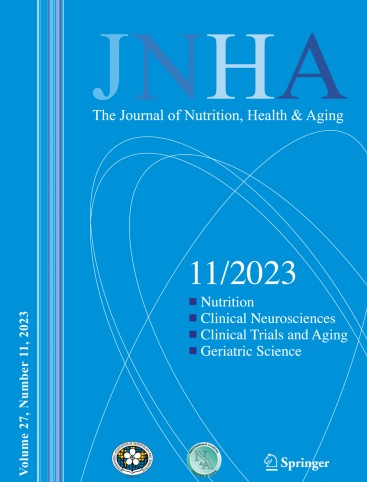The association of n-3 fatty acid intake with muscle mass and strength in older adults: A cross-sectional analysis of the UK biobank data
IF 4
3区 医学
Q1 GERIATRICS & GERONTOLOGY
引用次数: 0
Abstract
Objectives
The main aim was to investigate the association of n-3 fatty acid intake and the n-6/n-3 fatty acid intake ratio with muscle mass and strength in older adults.
Methods
This study included 61,381 individuals (28,187 men and 33,194 women) aged ≥60 years. Grip strength and muscle mass index were assessed and n-3 and n-6 fatty acid intake were determined. Regression models adjusted for age, deprivation index, ethnicity, month of assessment, total energy intake, multimorbidity, lifestyle factors and physical activity. A sensitivity analysis was conducted in participants aged ≥65 years and in people with sarcopenia.
Results
Data are presented as trend for quintiles from fully adjusted models. Higher n-3 fatty acid intake was associated with a higher grip strength in both men (0.114 kg; 95% CI: 0.02 to 0.21) and women (0.115 kg; 95% CI: 0.05 to 0.18). Similar results were reported for grip strength index, with no associations observed for muscle mass index. No associations were seen in people ≥65 years. In people with sarcopenia no associations of n-3 fatty acid intake with grip strength or grip strength index were seen, but a positive association with muscle mass index was noted in men (0.197 kg/m²; 95% CI: 0.05 to 0.33). The n-6/n-3 fatty acid intake ratio was associated with grip strength in women (0.081 kg; 95% CI: −0.16 to 0.000) and with muscle mass index in men (−0.016 kg/m²; 95% CI: −0.02 to 0.00), no other associations were observed. No associations were seen in people with sarcopenia or people ≥65 years.
Conclusion
Higher n-3 fatty acid intake, with no consistent association with the n-6/n-3 fatty acid intake, was modestly associated with grip strength, with effects varying by sex and age, suggesting limited benefit for sarcopenia prevention at typical intake levels in older adults.
老年人n-3脂肪酸摄入与肌肉质量和力量的关系:英国生物银行数据的横断面分析
目的探讨老年人n-3脂肪酸摄入量和n-6/n-3脂肪酸摄入比例与肌肉质量和力量的关系。方法纳入年龄≥60岁的61,381例(男性28,187例,女性33194例)。评估握力和肌肉质量指数,测定n-3和n-6脂肪酸摄入量。回归模型调整了年龄、剥夺指数、种族、评估月份、总能量摄入、多病、生活方式因素和身体活动。对年龄≥65岁和肌肉减少症患者进行敏感性分析。结果数据以完全调整模型的五分位数趋势表示。较高的n-3脂肪酸摄入量与两名男性的握力增加有关(0.114 kg;95% CI: 0.02 - 0.21)和女性(0.115 kg;95% CI: 0.05 ~ 0.18)。握力指数也有类似的结果,而肌肉质量指数则没有相关性。在≥65岁的人群中未见相关。在肌肉减少症患者中,n-3脂肪酸摄入量与握力或握力指数没有关联,但与男性肌肉质量指数呈正相关(0.197 kg/m²;95% CI: 0.05 ~ 0.33)。n-6/n-3脂肪酸摄入比例与女性握力相关(0.081 kg;95% CI: - 0.16至0.000),男性肌肉质量指数(- 0.016 kg/m²;95% CI:−0.02 ~ 0.00),未观察到其他关联。在肌肉减少症患者或年龄≥65岁的人群中未见相关。结论较高的n-3脂肪酸摄入量与n-6/n-3脂肪酸摄入量没有一致的相关性,但与握力有一定的相关性,其影响因性别和年龄而异,表明在老年人典型摄入量水平下预防肌肉减少症的益处有限。
本文章由计算机程序翻译,如有差异,请以英文原文为准。
求助全文
约1分钟内获得全文
求助全文
来源期刊
CiteScore
7.80
自引率
3.40%
发文量
136
审稿时长
4-8 weeks
期刊介绍:
There is increasing scientific and clinical interest in the interactions of nutrition and health as part of the aging process. This interest is due to the important role that nutrition plays throughout the life span. This role affects the growth and development of the body during childhood, affects the risk of acute and chronic diseases, the maintenance of physiological processes and the biological process of aging. A major aim of "The Journal of Nutrition, Health & Aging" is to contribute to the improvement of knowledge regarding the relationships between nutrition and the aging process from birth to old age.

 求助内容:
求助内容: 应助结果提醒方式:
应助结果提醒方式:


